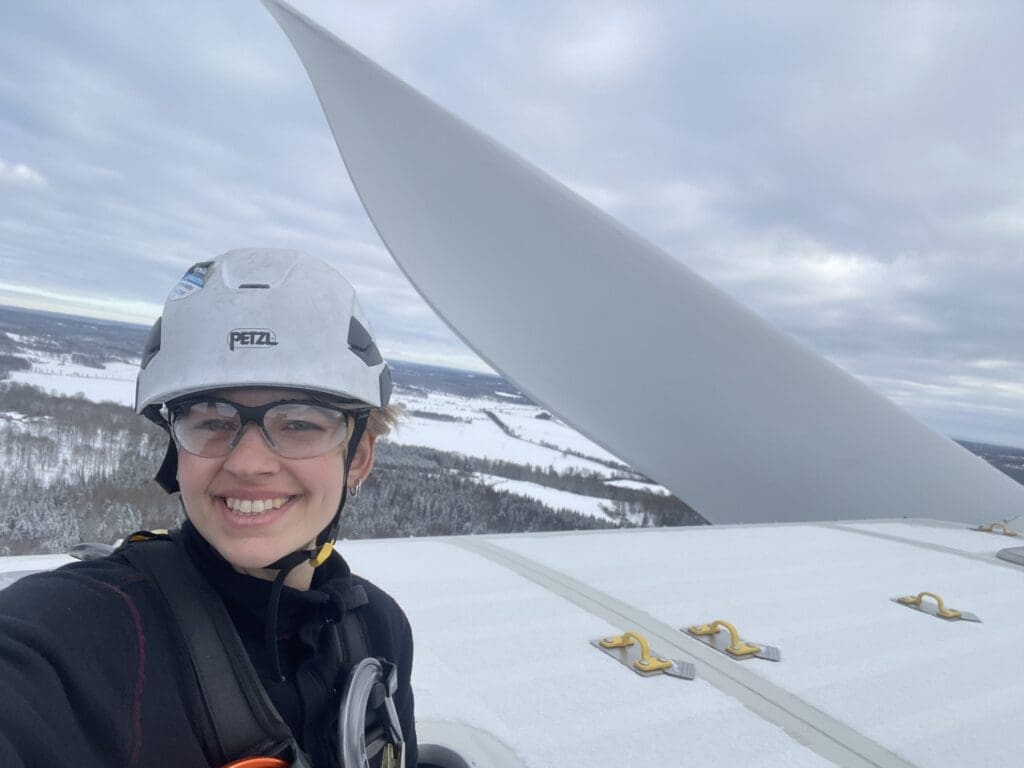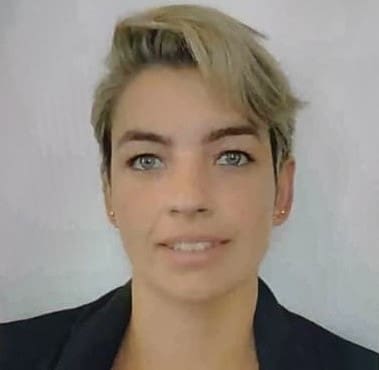Fascinating High Life of a Woman Wind Turbine Technician
This article focuses on the life of a wind turbine technician in Sweden. Nathalia Roberta Ferreira moved from working on aircraft in Brazil to working on wind turbines in Sweden. She shares her career and experience and knowledge about moving countries. Nathalia works for Vestas.


Life of a wind turbine technician for Vestas
Background
Could you give a brief description of your background?
I am from Brazil and have a degree in Aircraft Maintenance. So, after I graduated, I worked as an assembler technician on civilian airplanes.
Some years ago, Brazil and Sweden established a partnership. This partnership meant that Brazil bought 36 Saab JAS 39 Gripens and in return Sweden would teach Brazilian technicians how to build it. So, because of this partnership I was selected to work at Saab in Linköping as an assembler technician and learn how to build the Gripen E and F. I worked there for almost 4 years. During that time, I always saw wind turbines and thought to myself that it would be interesting to work up there.
Therefore, a little before my Saab contract ended, I started to research wind turbines and the companies we have here in Sweden. Then from the searches I figured out that Vestas was a good wind turbine company and I applied to get a job there.
So now I have been working at Vestas as a service technician for around one year. My job involves all kinds of maintenance to keep the turbine turning and generating electricity.
Interests and Inspirations
Were there any childhood interests which were a factor in your decision to study aircraft maintenance?
When I was 16 years old, I studied on a free university preparatory course where students from ITA (Instituto Tecnológico de Aeronáutica) university (the most important university in the aviation sector in Brazil) taught classes. On this course I had my first contact with aviation. One day I visited ITA and saw planes and how they worked and that was when I sparked my interest in the area of aircraft maintenance.
Who were your inspirations or role models?
My inspiration is my family. This is because, I come from a poor and humble family in Brazil. My parents didn’t finish school and so they did everything so that my sibling and I could have the chance to attend a good university and achieve our dreams.


Transferable skills from aircraft to wind turbines
You worked as an assembler technician before moving to the wind turbine industry. Which technical skills did you take with you?
In aviation, everything has to be done with great care, quality and attention to detail. So, always read the manuals before carrying out a task. I have taken these skills with me, always performing my work on the turbines with the highest possible level of quality.
Which soft skills transferred?
I developed my teamwork skills a lot, as the plane is built in separate parts that come together at the end. So, everyone has to help each other so that there are no problems in the final assembly. One assembly area is always in contact with the other, as well as the quality team. In addition, engineers are also always willing to help or listen to ideas for process improvements.
Culture and Adapting
You moved from Brazil to Sweden with Saab. How quickly did you learn Swedish?
I’m still learning Swedish. In Brazil, education is very poor. When I arrived in Sweden, my English was very basic, and I had a lot of difficulty communicating.
However, here in Sweden there is a programme for immigrants called SFI (Swedish for immigrants). So, I started studying English since everyone here speaks English and I had some prior knowledge. After I improved my English, I started to focus on Swedish, but I have to say that it is a very difficult language to speak. I can understand it, but pronouncing some words is very difficult haha.
What helped you to settle in to life and work in Sweden?
I joined a women’s football team in Linkoping called Hjulsbro IK. This helped me a lot to make new friends and adapt to my new life. In the winter I learned to ski, and I watched ice hockey. This is because, I believe that the best way to adapt is to connect with the country’s culture.
Swedish versus Brazilian working environment
What are the biggest differences in the working environment between Sweden and Brazil?
The biggest difference is in the treatment of people. In Sweden, bosses and the company care about the well-being of employees and their families. There is no pressure in the work environment, everyone knows what they have to do and the boss trusts that employees will perform in the best way. This means that there is a very pleasant environment.
In Brazil employees are treated like numbers by the company and if the employee is not satisfied with your performance, they fire you and hire someone else. Bosses pressure you to work overtime even though they know that sometimes you can’t, making employees feel afraid to say no and be fired. In Brazil, people work in fear of being fired and under pressure to always work faster.
Advice for moving
What advice would you give to someone who has just moved countries to work?
Understand the country’s culture.
Open your mind to learn new things.
Don’t compare the country with your homeland, as each country is different: there is no way it will be the same, and if you try to, it will only make you nostalgic and so make adapting more difficult.
Make your workplace a place you like to go to as it will be the first step towards your adaptation and making new friends.
Current role as a Wind Turbine Technician
What’s your typical week like?
In fact, I’m busy, from Monday to Friday as I work on the wind turbines. As well, after work I go to the gym and twice a week I play football, twice a week I ski with my friends from work and once a week I go to Swedish school.
How much of your time is spent ‘hands on’ on the turbines and how much on admin or other tasks?
Most days we spend all our time on the turbines. However, each time we finish a job we need about two hours to do the administrative part and prepare for the next task. We always work in pairs, so we share the administrative tasks, so we don’t need to spend a lot of time on it.
What size teams do you work in?
We work in pairs, but sometimes in threes.
What do you find most challenging when you are working?
When the turbine stops working and we have to find the problem. Sometimes it takes days of testing and analysis until we find the problem.
Have you ever arrived and found that it’s been much easier than you expected? For example, have you just needed to switch something on? (?)
Yes, once a team from Denmark did a maintenance service and during this service, they activated the hydraulic station and forgot to go back to the automatic system. So, after a few days the turbine stopped working, and we thought it could be something serious. Even though it had been serviced recently and so there shouldn’t have been a problem. When we got there, we saw that we just had to change the hydraulic station programming to automatic again.
Women in Science and Engineering
You have worked in industries where women are in a minority. How do you handle this situation? Do you think diverse teams are more successful?
I don’t see a problem with working in industries with a majority of men, having respect between both of course. And the good part is that one covers the other’s deficiencies.
What would you say to a woman who is considering working in the wind power industry?
Find the best way to do the things, as we don’t need to do things in the same way as the men do.
How do you think the diversity in engineering will change over the next ten years?
I think that more and more women will occupy engineering positions and with each passing year companies are becoming more equal in terms of having women in industries.
Physical fitness as a Wind Turbine Technician
Have you always liked being outside and active, and is this part of the reason you were attracted to working on wind turbines?
Yes, I like to be outside, and the turbines are very tall, and I like heights. So I saw wind turbines as an opportunity to use my knowledge and work at heights.
How important is physical fitness at work for you?
It’s good to exercise regularly, because sometimes we have to climb up, and also some tasks require strength. So if you are physically fit, the work gets easy to do.
How do you personally cope with the physical demands of working on wind turbines?
I don’t experience much difficulty, as I’m always working out or doing some physical activity. Although I don’t tend to experience any difficulty with physical tasks, if I do need help, my co-worker will definitely help me.


Working at heights
Can you describe the first time you worked at height?
It was on the wind turbine, when I reached the top of the turbine, the first thing I saw was the landscape. It’s an amazing view from the top of the turbine. The work itself doesn’t seem high up because we usually work inside the turbine.
How quickly did you become confident?
In terms of heights I never had a problem, but in terms of the work it was around 6 months. There are a lot of new things to learn about servicing a wind turbine, how to work safely because we have high voltages in the turbine, and how to proceed in case of fire or an accident.
What advice would you give someone in their first three months of working at heights?
Always wear the harness and the PPE, because they are the guarantees that you will be safe at height.
What sort of safety clothing, footwear, headwear and harnesses do you need to wear?
All the clothes should be flame retardant. I always wear safety glasses and shoes, helmet, long-sleeved shirts, gloves, and a harness.
How do you personally cope with the heat and the cold?
I’m from a tropical country, so the heat generated by the turbine is not uncomfortable for me. However, in the winter it is very difficult, as when the turbine is faulty for more than a day it becomes very cold, sometimes reaching -15 degrees. We have winter clothes, but sometimes the cold is very intense so that even with winter clothes we are very cold. However, normally the turbines are working and in these cases the gearbox causes the turbine to have an ambient temperature of around 19 degrees.


New wind turbine technicians
What is an important skill to have?
Electricity knowledge.
This is because due to the high voltages, it is very important to have knowledge and skills in electricity, as any mistake can be very dangerous.
What are the key things to do in your first month?
Pay attention to everything, listen to the experienced employees, if you have questions don’t hesitate to ask, and show you are interested in learning about the work.
What are the key things to do in your first year?
Becoming independent in the job, this does not mean working by yourself, but means being able to teach a new employee, and solve problems that occur during maintenance.
Further reading about wind turbines
Who repairs all the wind turbines you see everywhere?


Responses